NDE Terahertz Wave Techniques for Measurement of Defect Detection on Composite Panels of Honeycomb Sandwiches
Abstract
:1. Introduction
2. Basic Theory Approach
Refractive Index Measurements
3. Experimental Device and Measurements
3.1. Measurement Device
3.2. Measurement Technique
4. Results and Discussion
4.1. Measurement of the Refractive Index
4.2. Evaluation on Electric Field(E-Fields) of Composite Materials
4.3. THz Imaging of Foreign Marerials in Honeycomb Sandwich Composite Panels
5. Conclusions
- (1)
- The refractive index can be measured under reflection mode using T-rays, particularly with glass-fiber composite materials.
- (2)
- T-rays have limited transmission power to some degree for carbon-skin honeycomb sandwich composite panels, but T-ray transmission power was found to be related to the vector angles between the direction of the E-field and the direction of carbon fibers, thereby affecting the electrical conductivity of the composite panels and the E-field direction.
- (3)
- For the glass-skin honeycomb sandwich composite panels, scan images can be obtained using T-rays regardless of the E-field direction due to nonconducting materials. When utilizing carbon skins, optimal experimental techniques based on peak-to-peak amplitude can be acquired approximately at 90° between the direction of the E-field and the direction of carbon fibers, because T-rays can easily penetrate carbon fiber skins in honeycomb sandwich composite panels.
- (4)
- If T-ray systems can be produced to be inexpensive and portable, they may be highly useful and potentially nondestructive inspection tools in future applications.
Author Contributions
Funding
Conflicts of Interest
References
- Chiou, C.P.; Blackshire, J.L.; Thompson, R.B.; Hu, B.B. Terahertz Ray System Calibration and Material Characterzations. Rev. QNDE 2009, 28, 410–417. [Google Scholar]
- Im, K.H.; Lee, K.S.; Yang, I.Y.; Yang, Y.J.; Seo, Y.H.; Hsu, D.K. Advanced T-ray Nondestructive Evaluation of Defects in FRP Solid Composites. Inter. J. Precis. Eng. Manuf. 2013, 14, 1093–1098. [Google Scholar] [CrossRef]
- Li, M.W.; Liang, C.P.; Zhang, Y.B.; Yi, Z.; Chen, X.F.; Zhou, Z.G.; Yang, H.; Tang, Y.J.; Yi, Y.G. Terahertz Wideband Perfect Absorber Based on Open Loop with Cross Nested Structure. Results Phys. 2019, 15, 102603. [Google Scholar] [CrossRef]
- Chunlian, C.; Zhang, Y.; Chen, X.; Yang, H.; Yi, Z.; Yao, W.; Tang, Y.; Yi, Y.; Wang, J.; Wu, P. A Dual-Band Metamaterial Absorber for Graphene Surface Plasmon Resonance at Terahertz Frequency. Phys. E Low-Dimens. Syst. Nanostruct. 2020, 117, 113840. [Google Scholar] [CrossRef]
- Zhang, Y.; Wu, P.; Zhou, Z.; Chen, X.; Yi, Z.; Zhu, J.; Zhang, T.; Jile, H. Study on Temperature Adjustable Terahertz Metamaterial Absorber Based on Vanadium Dioxide. IEEE Access 2020, 8, 85154–85161. [Google Scholar] [CrossRef]
- Im, K.-H.; Kim, S.-K.; Jung, J.-A.; Cho, Y.-T.; Woo, Y.-D.; Chiou, C.-P. NDE Detection Techniques and Characterization of Aluminum Wires Embedded in Honeycomb Sandwich Composite Panels Using Terahertz Waves. Materials 2019, 12, 1264. [Google Scholar] [CrossRef] [PubMed] [Green Version]
- Hsu, D.K.; Lee, K.S.; Park, J.W.; Woo, Y.D.; Im, K.H. NDE Inspection of Terahertz Waves in Wind Turbine Composites. Inter. J. Precis. Eng. Manuf. 2012, 13, 1183–1189. [Google Scholar] [CrossRef]
- Huber, R.; Brodschelm, A.; Tauser, A.; Leitenstorfer, A. Generation and Field-Resolved Detection of Femtosecond Electromagnetic Pulses Tunable up to 41 THz. Appl. Phys. Lett. 2000, 76, 3191–3199. [Google Scholar] [CrossRef]
- Rudd, J.V.; Mittleman, D.M. Influence of Substrate-Lens Design in Terahertz Time-Domain Spectroscopy. J. Opt. Soc. Am. B 2000, 19, 319–329. [Google Scholar] [CrossRef]
- Gregory, I.S.; Baker, C.; Tribe, W.; Bradley, I.V.; Evans, M.J.; Linfield, E.H. Optimization of Photomixers and Antennas for Continuous-Wave Terahertz Emission. IEEE J. Quantum Electron. 2000, 41, 717–728. [Google Scholar] [CrossRef] [Green Version]
- Brown, E.R.; Smith, F.W.; McIntosh, K.A. Coherent Millimeterwave Generation by Heterodyne Conversion in Low-Temperature-Grown GaAs Photoconductors. J. Appl. Phys. 1993, 73, 1480–1484. [Google Scholar] [CrossRef] [Green Version]
- Brown, E.R.; McIntosh, K.A.; Nichols, K.B.; Dennis, C.L. Photomixing up to 3.8 THz in Low-Temperature-Grown GaAs. Appl. Phys. Lett. 1995, 66, 285–287. [Google Scholar] [CrossRef]
- Zhang, J.; Li, W.; Cui, H.L.; Shi, C.; Han, X.; Ma, Y.; Chen, J.; Chang, T.; Wei, D.; Zhang, Y.; et al. Nondestructive Evaluation of Carbon Fiber Reinforced Polymer Composites Using Reflective Terahertz Images. Sensors 2016, 16, 875. [Google Scholar] [CrossRef] [Green Version]
- Li, L.; Yang, W.; Shui, T.; Wang, X. Ultrasensitive Sizing Sensor for a Single Nanoparticle in a Hybrid Nonlinear Microcavity. IEEE Photonics J. 2020, 12, 1–8. [Google Scholar] [CrossRef]
- Wu, P.; Chen, Z.; Jile, H.; Zhang, C.; Xu, D.; Lv, L. An Infrared Perfect Absorber Based on Metal-Dielectric-Metal Multi-Layer Films with Nanocircle Holes Arrays. Results Phys. 2020, 16, 102952. [Google Scholar] [CrossRef]
- Schueler, R.; Joshi, S.P.; Schulte, K. Damage Detection in CFRP by Electrical Conductivity Mapping. Compos. Sci. Technol. 2001, 61, 921–930. [Google Scholar] [CrossRef]
- Hsu, D.K. Characterization of a Graphite/Epoxy Laminate by Electrical Resistivity Measurements. Rev. QNDE 1985, 4, 1219–1228. [Google Scholar]
- Tse, K.W.; Moyer, C.A.; Arajs, S. Electrical Conductivity of Graphite Fiber epoxy Resin Composites. Mater. Sci. Eng. 1981, 49, 41–46. [Google Scholar] [CrossRef]


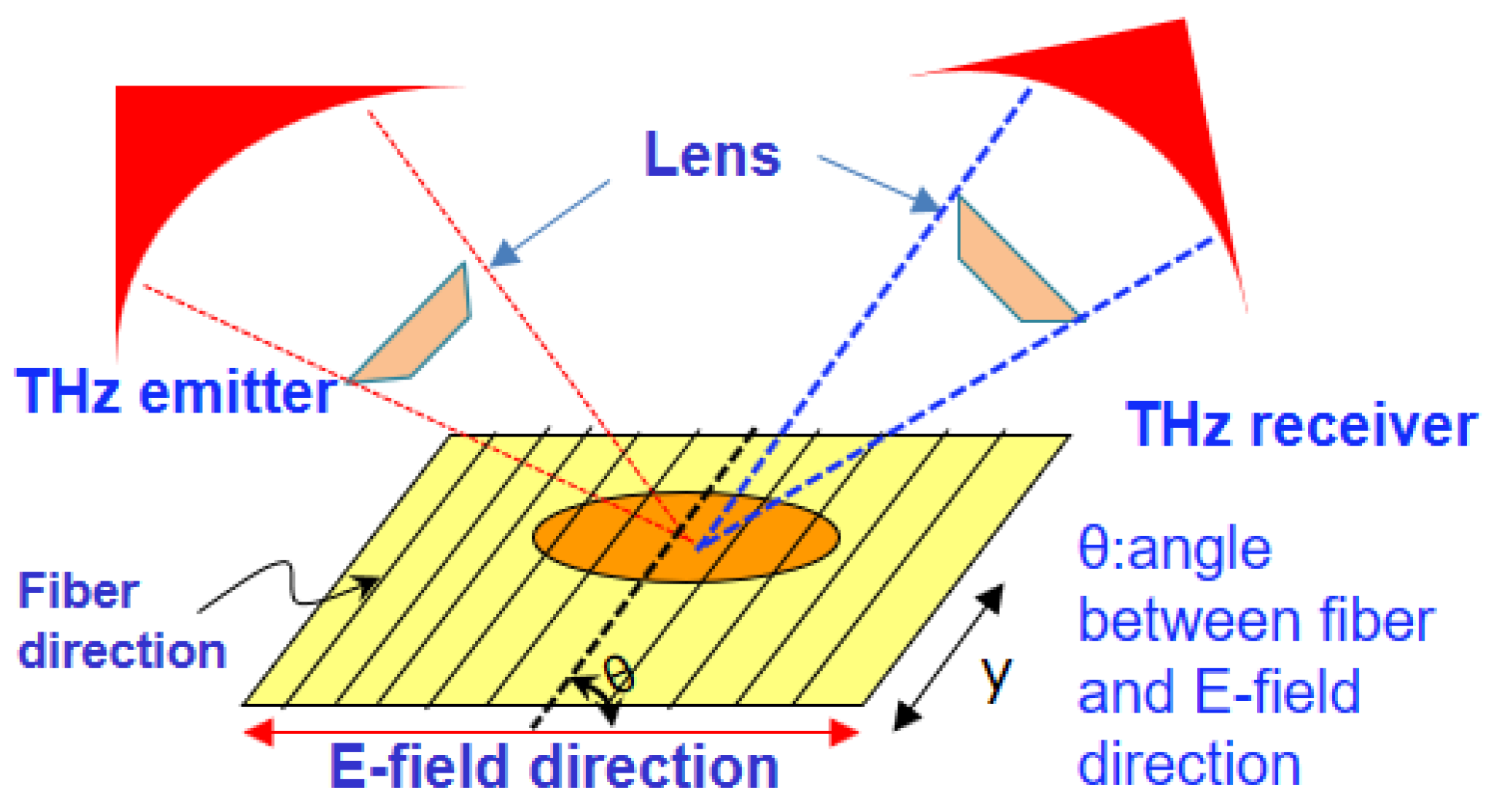
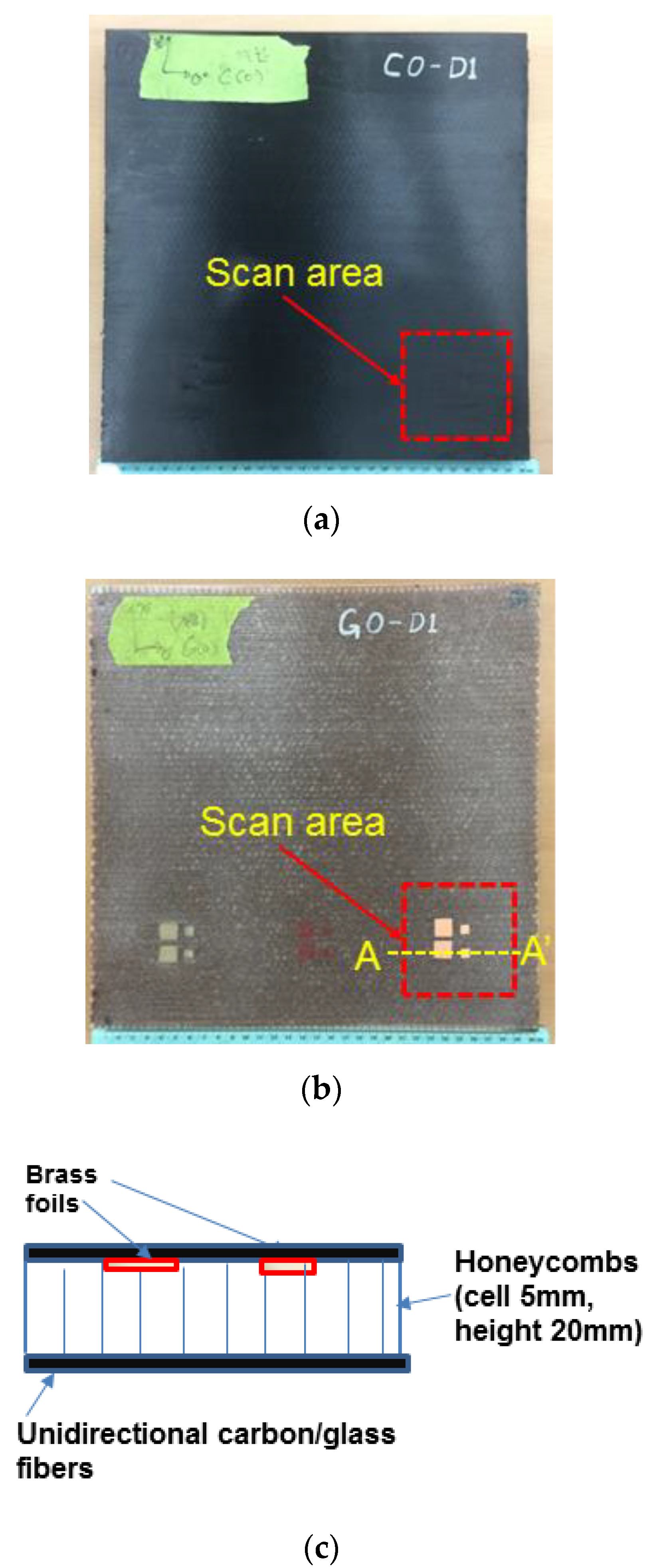
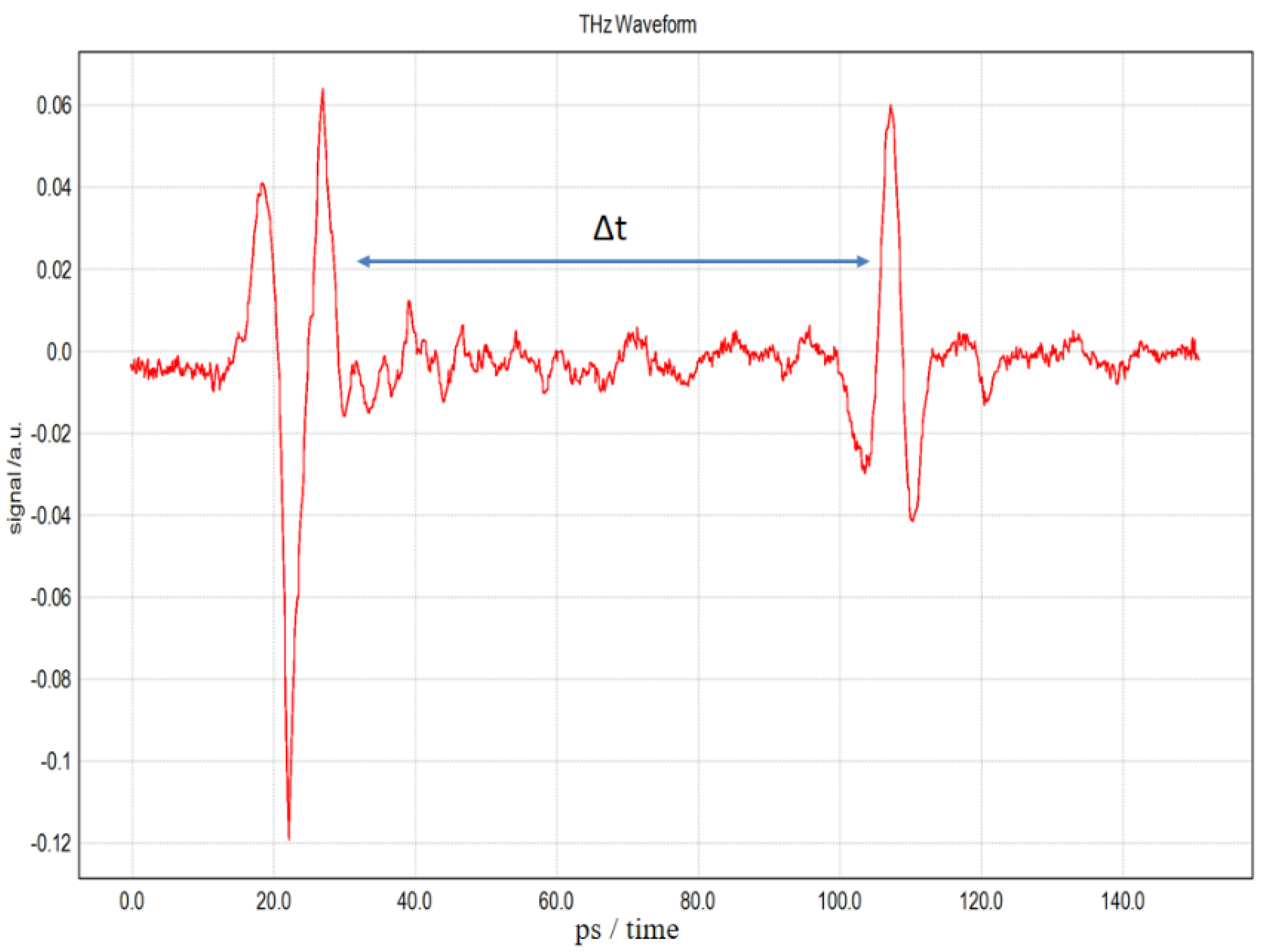

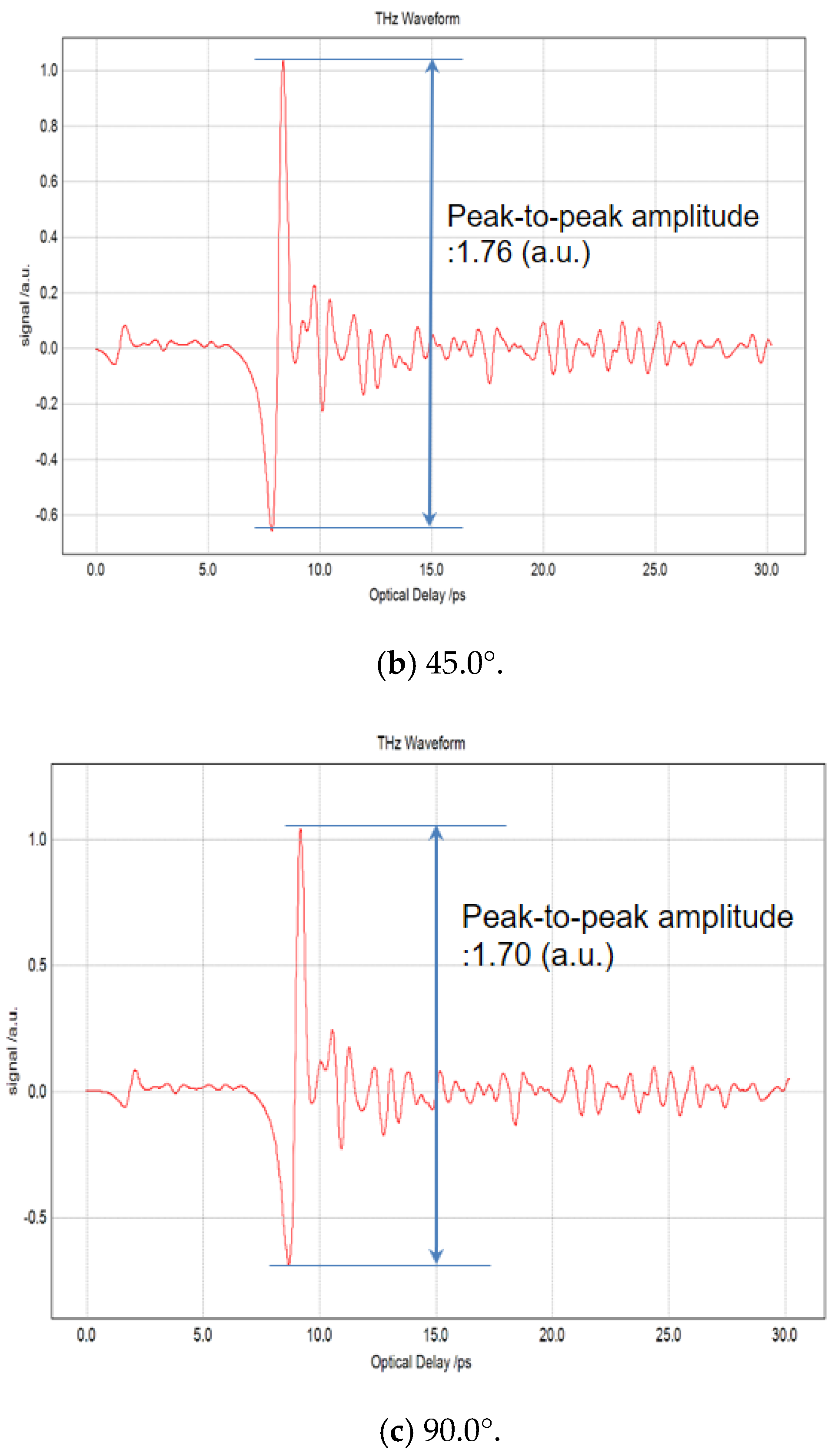
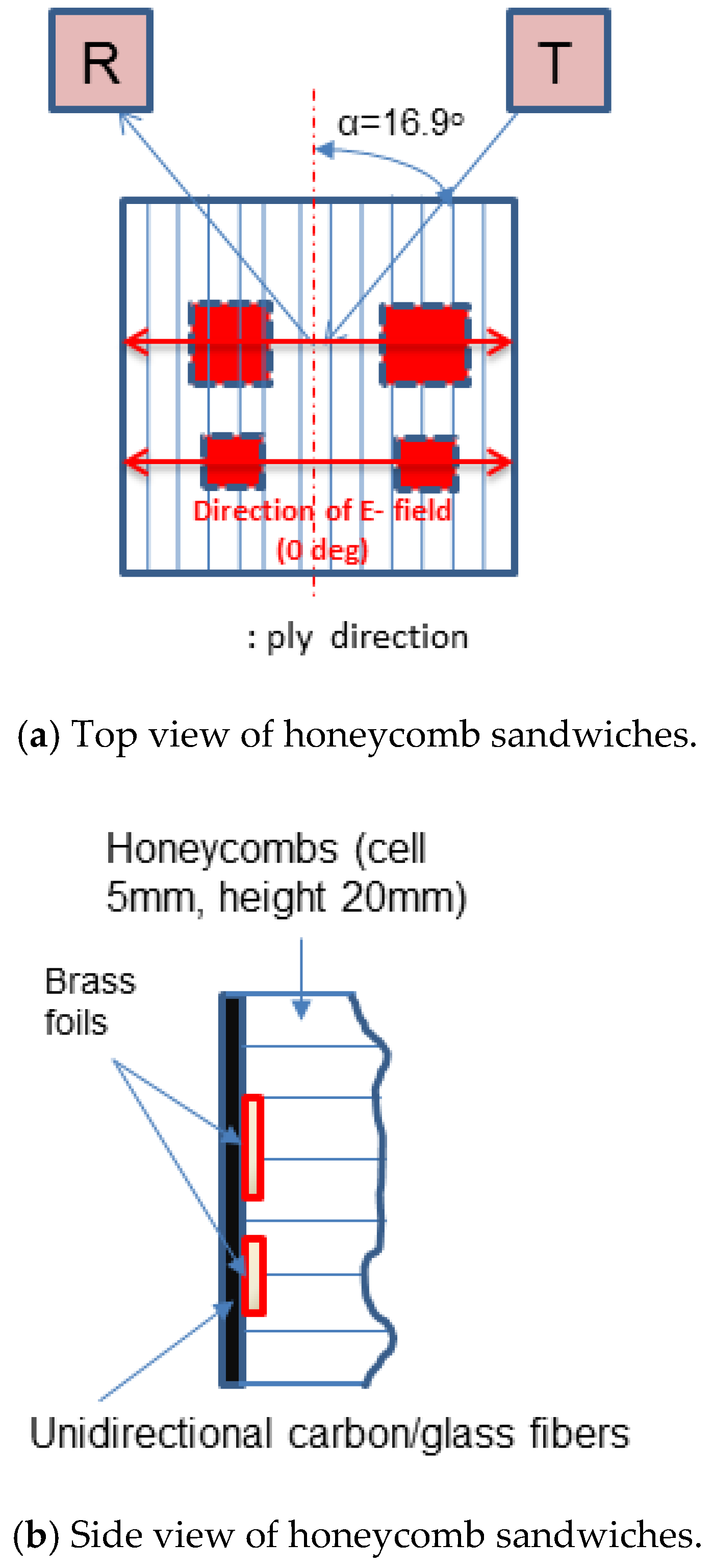



| Materials | Refractive Index (n) * | Refractive Index (n) |
|---|---|---|
| Reflection Mode | ||
| Poly methyl methacrylate (PMMA) | 1.60 ± 0.08 | 1.58 ± 0.07 |
| Fused quartz | 1.95 ± 0.05 | 1.95 ± 0.05 |
| GFRPs | - | 2.17 ± 0.05 |
| Resistance | Angles | ||
|---|---|---|---|
| 0° | 45.0° | 90.0° | |
| θ | 0° | 45.0° | 90.0° |
| σ1 | 1 | 0.5 | 0 |
| σ | 1.0 cos2θ | 0.5 cos2θ | 0 cos2θ |
| Req | 1 | 0.25 | 0 |
© 2020 by the authors. Licensee MDPI, Basel, Switzerland. This article is an open access article distributed under the terms and conditions of the Creative Commons Attribution (CC BY) license (http://creativecommons.org/licenses/by/4.0/).
Share and Cite
Im, K.-H.; Kim, S.-K.; Jung, J.-A.; Cho, Y.-T.; Woo, Y.-D.; Chiou, C.-P. NDE Terahertz Wave Techniques for Measurement of Defect Detection on Composite Panels of Honeycomb Sandwiches. Electronics 2020, 9, 1360. https://doi.org/10.3390/electronics9091360
Im K-H, Kim S-K, Jung J-A, Cho Y-T, Woo Y-D, Chiou C-P. NDE Terahertz Wave Techniques for Measurement of Defect Detection on Composite Panels of Honeycomb Sandwiches. Electronics. 2020; 9(9):1360. https://doi.org/10.3390/electronics9091360
Chicago/Turabian StyleIm, Kwang-Hee, Sun-Kyu Kim, Jong-An Jung, Young-Tae Cho, Yong-Deuck Woo, and Chien-Ping Chiou. 2020. "NDE Terahertz Wave Techniques for Measurement of Defect Detection on Composite Panels of Honeycomb Sandwiches" Electronics 9, no. 9: 1360. https://doi.org/10.3390/electronics9091360





